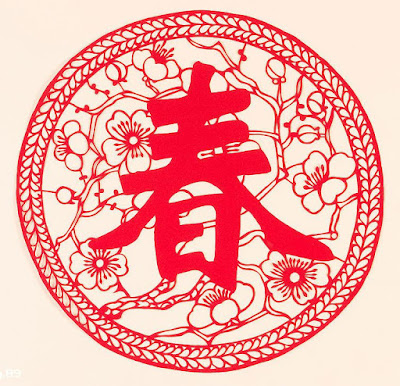The Chinese Lunar New Year is also known as the Spring Festival
(Image: Nipic.com)
The Chinese lunar new year is celebrated on the first day of the first month according to the Chinese lunar calender. And while information about the background of Chinese New Year is nothing really unique in the blogosphere, here are some interesting religio-cultural facts regarding Chinese New Year’s day that may not be common knowledge.
The Chinese Buddhist tradition considers the Chinese New Year to be the Birthday of Bodhisattva Maitreya (also known as Maitreya Buddha) (彌勒菩薩聖誕 Mile Pusa Shengdan). On the same day, the Taoist tradition considers it to be the Birthday of the Celestial Venerable of Primordial Beginning (元始天尊聖誕 Yuanshi Tianzun Shengdan) and also the Festival Day of Heaven (天臘之辰 Tianla Zhichen).
According to Buddhism, Maitreya, now a bodhisattva, will be the next Buddha to appear in the future at a time when the Buddhist teachings have completely vanished from the earth.
 |
Maitreya, the Future Buddha – in the form of Budai Heshang
(Image: Hudong.com) |
Just as Siddhartha Gautama, the historical Buddha, renounced his worldly role and chose to pursue the way to enlightenment, all the Buddhas of the future will likewise do the same. Because there are countless sentient beings in the infinite universe, there are, and always will be, countless Buddhas – as all sentient beings possess the potential for attaining enlightenment. The exact time when Maitreya will appear in the future is not clearly known, as there are different ways of calculating the number of years according to different texts existing in the Buddhist tradition, but it is safe to say that it will be billions of years from now. In the Chinese Buddhist tradition, it is believed that one of the emanations of Maitreya was the 10th century monk Budai Heshang (布袋和尚) (subject of a previous blog post entitled “Happy Buddha” which can be found here). The fat and jolly monk Budai Heshang was a somewhat mysterious figure, and since nobody knew what his actual birth date was, and furthermore, certainly nobody now knows what will be the actual birth date of the coming Buddha Maitreya, the first day of the first month is taken to honor the future Buddha.
 |
The Celestial Venerable of Primordial Beginning
(Image: Ctcwri.idv.tw) |
He is also known as the Jade Purity (玉清 Yuqing) and is the central figure of the Three Pure Ones (三清 Sanqing), a holy trinity of supreme deities in religious Taoism. Because he is a personification of the abstract primordial beginning or origin, it makes sense to take as his “birth date” the first day of the first month of the new year. In addition to honoring the Celestial Venerable of Primordial Beginning on New Year’s day, Taoists also consider this day to be the Festival Day of Heaven, a day for paying respects to Heaven by making offerings and also praying for continued blessings and fortune. Heaven worship was a religious concept and practice that was observed in ancient times that even predates organized religion in China
Happy birthday to Bodhisattva/Buddha Maitreya and the Celestial Venerable of Primordial Beginning! And Happy New Year to everyone else!




